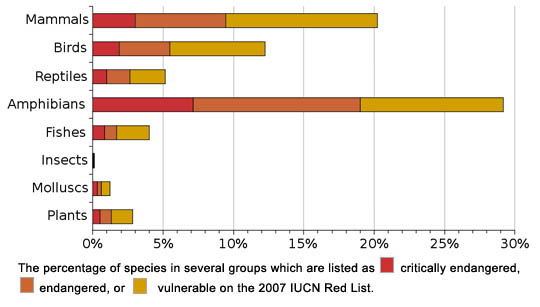show/hide words to know
What is an Endangered Species?
Extinction is a natural fact, and a lot of species have gone extinct in the past. You don’t see dinosaurs walking down your street today because they went extinct about 65 million years ago. Extinction is a natural process. But it is sometimes considered unnatural when humans cause extinction. Perhaps a species is overhunted like the dodo. Or maybe the forest that a certain kind of bird lives in is cut down and turned into farmland. If a species starts to decrease in number because of human action, some people get concerned. If their numbers get too low they might be considered to be in danger of extinction. When this happens the species is called an endangered species. If enough scientists agree, it is put on the endangered species list. To protect species on the endangered species list the government might make it illegal to hunt it, or turn a portion of the forest the species lives in into a national park to prevent it from being cut down.
Getting Off the Endangered List
Once a species is put on the endangered species list there are three ways for it to be removed from the list, or to be delisted. One way is for new information to be discovered which reveals that the species was never actually endangered to begin with. The second way is for the species to increase in numbers enough to be considered recovered, as was the case with the American bald eagle. Lastly, the species can be delisted because it's become extinct. The dusky seaside sparrow was not so lucky as the bald eagle. It was delisted(link is external) when protection efforts failed and it became extinct. Since the Endangered Species Act was passed in 1973, the federal government has delisted 47 species.

Alert levels for endangered species |
|
The International Union for Conservation of Nature (IUCN) uses these categories for species status. Extinct (EX) - No individuals remaining. Extinct in the Wild (EW) - Known only to survive in captivity, or as a naturalized population outside its historic range. Critically Endangered (CR) - Extremely high risk of extinction in the wild. Endangered (EN) - High risk of extinction in the wild. Vulnerable (VU) - High risk of endangerment in the wild. Near Threatened (NT) - Likely to become endangered in the near future. Least Concern (LC) - Lowest risk. Does not qualify for a more at risk category. Widespread and abundant taxa are included in this category. |
The International Union for the Conservation of Nature, or IUCN, keeps the most complete list of endangered species in the world. The IUCN list is called the Red List(link is external) instead of the Red Book. It uses the chart above to tell how serious the threat of extinction is to each species on the list. The chart below tells how many of each kind of species are on the Red List.

View Citation

The Dusky Seaside Sparrow went extinct in 1987.
Be Part of
Ask A Biologist
By volunteering, or simply sending us feedback on the site. Scientists, teachers, writers, illustrators, and translators are all important to the program. If you are interested in helping with the website we have a Volunteers page to get the process started.








